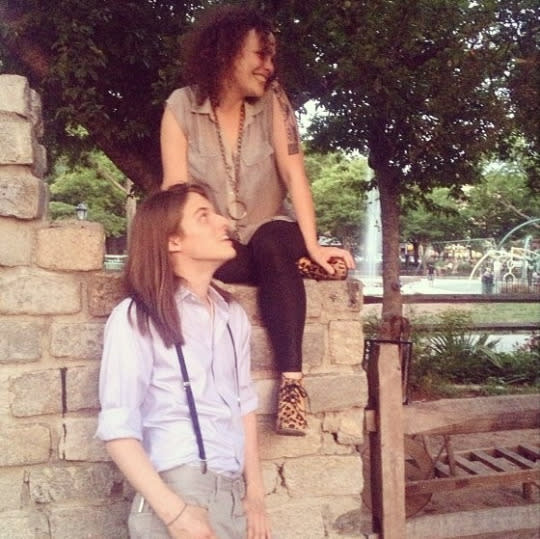The Secrets I’m No Longer Keeping as a Woman
I get compliments on this photo. Jared and I are newly engaged, attending a wedding in a historic Brooklyn house on a perfect Saturday evening. We’re prototypical, with an ideal Instagram filter and playful and spontaneous smiles. We are deeply in love; our outfits are fresh.

Nadine sitting and Jared standing outside near a fountain, smiling and looking away from the camera. (Photo: Nadine Friedman-Roberts)
In this photo, we also have a secret. I was bleeding, six days into a miscarriage. I am trying to forget my pain in this photo. We’d have to leave the wedding early, my cramps so awful I’d crawl into a cab. I laid on the couch, picking at pastries the worried bride sent us home with and waiting for it to pass. This was my second miscarriage, and while six days seemed strangely long, a doctor had reassured me it would be fine.
Related: My Son Only Lived for 80 Minutes, but He Helped Save Many Lives
The Monday before the wedding, we’d visited a reproductive endocrinologist with a $75 copay. I reported the nine positive pregnancy tests which preceded obvious signs of miscarriage — cramps, blood, my previous loss. He told me it would run its course but dutifully started a transvaginal ultrasound.
Paper crunching beneath me, I became increasingly aware of being surrounded by men: the doctor, my worried husband and two residents. I became preoccupied with the idea that every man in the room wore clothes, wore shoes, while I lay exposed and trying not to curl up. He swirled the wand inside me and casually said, “There’s nothing there. Maybe a miscarriage. You’ll be OK.”
I would not.
A week after this photo, the bleeding got progressively worse. I called the doctor’s office to express my concern. The nurse told me miscarriages could last for weeks sometimes. I trusted them.
One week after that: I was still bleeding and didn’t understand why. I went to a woman’s health clinic. The doctor, a woman, heard my story. Listened. And instead of affirming this was just an insulting exercise in endurance, she sent me to the ER.
Related: The Odd Thing About This Picture Taught Me a Lesson We All Need to Learn
It was an ectopic pregnancy, an embryo glued to my left fallopian tube. Turns out in this photo, I was harboring a clump of cells that would have grown until the tube exploded, causing internal bleeding. It could have happened anytime. There was, contrary to the specialist’s opinion, most definitely something there.
I had an ultrasound at the hospital in a dark room.
“How many pregnancies?” asked the technician.
“Two,” I replied.
“How many children?”
“None.”
A pause. She was a silhouette, but her secondhand disappointment, her sadness for me, was clear.
“No children? At all?”
Related: To the Woman in the ER Waiting Room Who Told Me I Was Lucky
Two pregnancies, no children, nine tests, five weeks, one photo.
I was at the ER for 12 hours, blood soaking the hospital sheets while I sobbed and gripped my husband. I received a methotrexate injection and the tiny, homicidal lump of cells in my tube eventually melted, reabsorbed into me.
While it’s lovely, this photo is full of secrets. I love this man, but he can’t see my sorrow and shame. I want so badly to join the world, to build a family with him, but I keep that pain to myself. And the thing growing inside me is hiding, too, ready to destroy and disappoint me. It could have given us joy, but a biological mishap made it ferocious.
As women, we must honor our experiences and tell our real stories. We must challenge institutions that tell us we’re not entitled to our pain, that we’re to blame, that we’re alone. That “there’s nothing there.” We are there.
I see my pain in this photo and am afraid to look. But when I tell the truth, the story changes: I hear the laugh of my beloved man, who I’ll marry and worship. I smell the fountain’s freshness. I feel the fading sun on my face and the cool, ancient stone under my palms. I see something else.
More from The Mighty:
What This Sex-Positive Party’s Success Really Means
I Let My 4-Year-Old With Autism Use My Camera. Here’s How He Sees the World.
I Have OCD. This Is What It’s Like to Be in My Mind for 3 Minutes.
